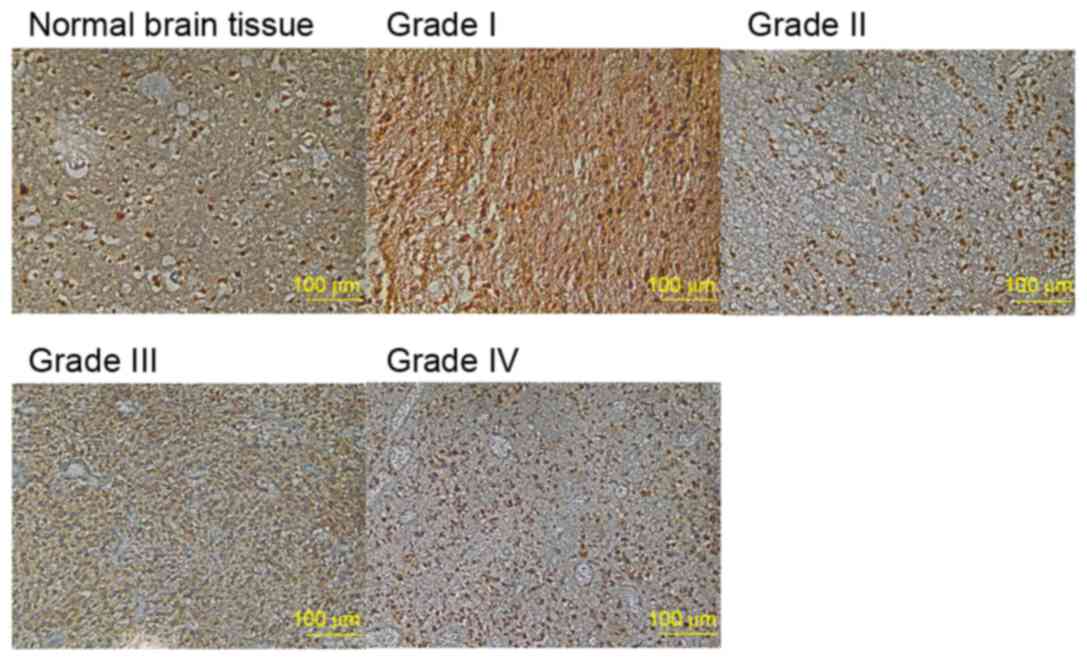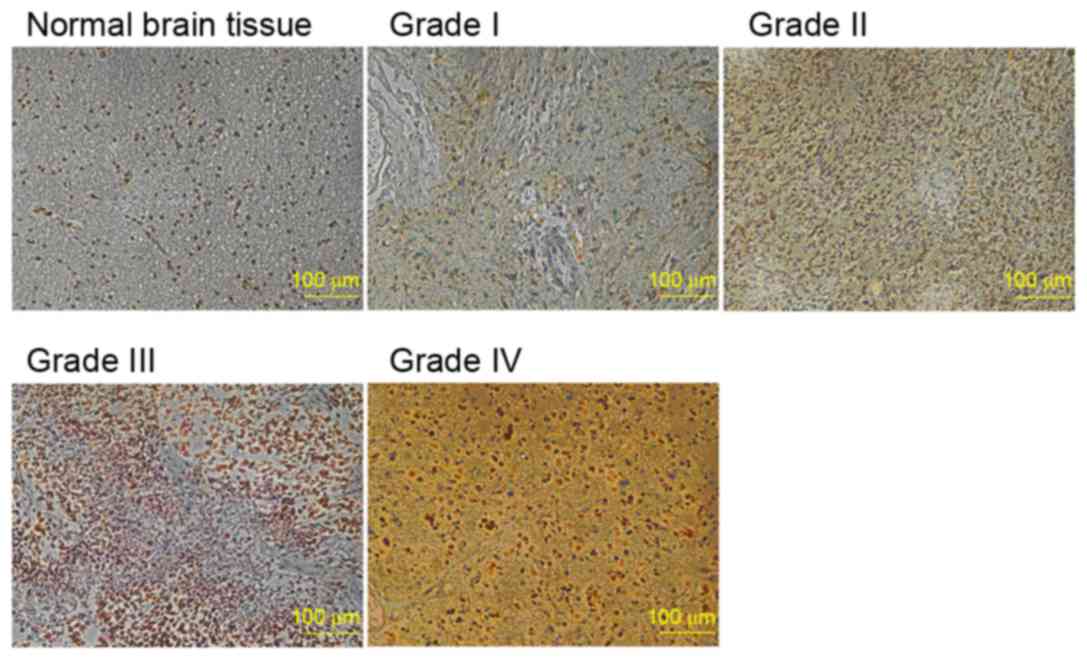|
1
|
Louis DN, Ohgaki H, Wiestler OD, Cavenee
WK, Burger PC, Jouvet A, Scheithauer BW and Kleihues P: The 2007
WHO classification of tumors of the central nervous system. Acta
Neuropathol. 114:97–109. 2007. View Article : Google Scholar : PubMed/NCBI
|
|
2
|
Xu L, Li Z, Tao Y, Li RH, Fang F, Zhao H,
Li G, Li YH, Wang J, Feng X and Pan J: Histone acetyltransferase
inhibitor II induces apoptosis in glioma cell lines via the p53
signaling pathway. J Exp Clin Cancer Res. 33:1082014. View Article : Google Scholar : PubMed/NCBI
|
|
3
|
Kim HS and Lee MS: STAT1 as a key
modulator of cell death. Cell Signal. 19:454–465. 2007. View Article : Google Scholar : PubMed/NCBI
|
|
4
|
Bruyère C, Madonna S, Van Goietsenoven G,
Mathieu V, Dessolin J, Kraus JL, Lefranc F and Kiss R: JLK1486, a
Bis 8-hydroxyquinoline-substituted benzylamine, displays cytostatic
effects in experimental gliomas through MyT1 and STAT1 activation
and, to a lesser extent, PPARγ activation. Transl Oncol. 4:126–137.
2011. View Article : Google Scholar : PubMed/NCBI
|
|
5
|
Strobl B and Moriggl R: Recovery from
chemotherapy depends on STAT1 for replenishment of B lymphopoiesis.
J Leukoc Biol. 95:849–851. 2014. View Article : Google Scholar : PubMed/NCBI
|
|
6
|
Kim EL, Wüstenberg R, Rübsam A,
Schmitz-Salue C, Warnecke G, Bücker EM, Pettkus N, Speidel D, Rohde
V, Schulz-Schaeffer W, et al: Chloroquine activates the p53 pathway
and induces apoptosis in human glioma cells. Neuro Oncol.
12:389–400. 2010. View Article : Google Scholar : PubMed/NCBI
|
|
7
|
Youlyouz-Marfak I, Gachard N, Le Clorennec
C, Najjar I, Baran-Marszak F, Reminieras L, May E, Bornkamm GW,
Fagard R and Feuillard J: Identification of a novel p53-dependent
activation pathway of STAT1 by antitumour genotoxic agents. Cell
Death Differ. 15:376–385. 2008. View Article : Google Scholar : PubMed/NCBI
|
|
8
|
Yue X, Zhao Y, Xu Y, Zheng M, Feng Z and
Hu W: Mutant p53 in cancer: Accumulation, gain-of-function, and
therapy. J Mol Biol. 429:1595–1606. 2017. View Article : Google Scholar : PubMed/NCBI
|
|
9
|
Xi S, Dyer KF, Kimak M, Zhang Q, Gooding
WE, Chaillet JR, Chai RL, Ferrell RE, Zamboni B, Hunt J and Grandis
JR: Decreased STAT1 expression by promoter methylation in squamous
cell carcinogenesis. J Natl Cancer Inst. 98:181–189. 2006.
View Article : Google Scholar : PubMed/NCBI
|
|
10
|
Ju H, Li X, Li H, Wang X, Wang H, Li Y,
Dou C and Zhao G: Mediation of multiple pathways regulating cell
proliferation, migration, laboratory investigation. J Neurosurg.
118:1239–1247. 2013. View Article : Google Scholar : PubMed/NCBI
|
|
11
|
Huang S, Bucana CD, Van Arsdall M and
Fidler IJ: Stat1 negatively regulates angiogenesis, tumorigenicity
and metastasis of tumor cells. Oncogene. 21:2504–2512. 2002.
View Article : Google Scholar : PubMed/NCBI
|
|
12
|
Barry SP, Townsend PA, Knight RA,
Scarabelli TM, Latchman DS and Stephanou A: STAT3 modulates the DNA
damage response pathway. Int J Exp Pathol. 91:506–514. 2010.
View Article : Google Scholar : PubMed/NCBI
|
|
13
|
Thomas M, Finnegan CE, Rogers KM, Purcell
JW, Trimble A, Johnston PG and Boland MP: STAT1: A modulator of
chemotherapy-induced apoptosis. Cancer Res. 64:8357–8364. 2004.
View Article : Google Scholar : PubMed/NCBI
|
|
14
|
Zhu H, Wang Z, Xu Q, Zhang Y, Zhai Y, Bai
J, Liu M, Hui Z and Xu N: Inhibition of STAT1 sensitizes renal cell
carcinomacells to radiotherapy and chemotherapy. Cancer Biol Ther.
13:401–407. 2012. View Article : Google Scholar : PubMed/NCBI
|
|
15
|
McDermott U, Longley DB, Galligan L, Allen
W, Wilson T and Johnston PG: Effect of p53 status and STAT1 on
chemotherapy-induced, Fas-mediated apoptosis in colorectal cancer.
Cancer Res. 65:8951–8960. 2005. View Article : Google Scholar : PubMed/NCBI
|
|
16
|
Duan X, Ponomareva L, Veeranki S,
Panchanathan R, Dickerson E and Choubey D: Differential roles for
the interferon-inducible IFI16 and AIM2 innate immune sensors for
cytosolic DNA in cellular senescence of human fibroblasts. Mol
Cancer Res. 9:589–602. 2011. View Article : Google Scholar : PubMed/NCBI
|
|
17
|
Liu K, Caldwell SA and Abrams SI: Immune
selection and emergence of aggressive tumor variants as negative
consequences of Fas-mediatedcytotoxicity and altered
IFN-gamma-regulated gene expression. Cancer Res. 65:4376–4388.
2005. View Article : Google Scholar : PubMed/NCBI
|
|
18
|
Lake RA and Robinson BW: Immunotherapy and
chemotherapy-a practical partnership. Nat Rev Cancer. 5:397–405.
2005. View
Article : Google Scholar : PubMed/NCBI
|
|
19
|
Dunn GP, Koebel CM and Schreiber RD:
Interferons, immunity and cancer immunoediting. Nat Rev Immunol.
6:836–848. 2006. View
Article : Google Scholar : PubMed/NCBI
|
|
20
|
Watanabe T, Katayama Y, Yoshino A, Komine
C and Yokoyama T: Deregulation of the TP53/p14ARF tumor suppressor
pathway in low-grade diffuse astrocytomas and its influenceon
clinical course. Clin Cancer Res. 9:4884–4890. 2003.PubMed/NCBI
|
|
21
|
Wang YY, Zhang T, Li SW, Qian TY, Fan X,
Peng XX, Ma J, Wang L and Jiang T: Mapping p53 mutations in
low-grade glioma: A voxel-based neuroimaging analysis. AJNR Am J
Neuroradiol. 36:70–76. 2015. View Article : Google Scholar : PubMed/NCBI
|
|
22
|
Cohen AL and Colman H: Glioma biology and
molecular markers. Cancer Treat Res. 163:15–30. 2015. View Article : Google Scholar : PubMed/NCBI
|
|
23
|
Bell HS and Ryan KM: Targeting the p53
family for cancer therapy: ‘Big brother’ joins the fight. Cell
Cycle. 6:1995–2000. 2007. View Article : Google Scholar : PubMed/NCBI
|
|
24
|
Fedrigo CA, Grivicich I, Schunemann DP,
Chemale IM, dos Santos D, Jacovas T, Boschetti PS, Jotz GP, Filho
Braga A and da Rocha AB: Radioresistance of human glioma spheroids
and expression of HSP70, p53 and EGFr. Radiat Oncol. 6:1562011.
View Article : Google Scholar : PubMed/NCBI
|
|
25
|
Biddlestone-Thorpe L, Sajjad M, Rosenberg
E, Beckta JM, Valerie NC, Tokarz M, Adams BR, Wagner AF, Khalil A,
Gilfor D, et al: ATM kinase inhibition preferentially sensitizes
p53 mutant glioma to ionizing radiation. Clin Cancer Res.
19:3189–3200. 2013. View Article : Google Scholar : PubMed/NCBI
|
|
26
|
Lang FF, Yung WK, Raju U, Libunao F, Terry
NH and Tofilon PJ: Enhancement of radiosensitivity of wild-type p53
human glioma cells by adenovirus-mediated delivery of the p53 gene.
J Neurosurg. 89:125–132. 1988. View Article : Google Scholar
|
|
27
|
Broaddus WC, Liu Y, Steele LL, Gillies GT,
Lin PS, Loudon WG, Valerie K, Schmidt-Ullrich RK and Fillmore HL:
Enhanced radiosensitivity of malignant glioma cell after adenoviral
p53 transduction. J Neurosurg. 91:997–1004. 1999. View Article : Google Scholar : PubMed/NCBI
|
|
28
|
Xiang W, Zhu XL and Zhao HY: Therapeutic
effect of p53 gene combined with cisplatin on experimental glioma.
Chin J Clin Neurosur. 11:154–156. 2006.(In Chinese).
|
|
29
|
Townsend PA, Scarabelli TM, Davidson SM,
Knight RA, Latchman DS and Stephanou A: STAT-1 interacts with p53
to enhance DNA damage-induced apoptosis. J Biol Chem.
279:5811–5820. 2004. View Article : Google Scholar : PubMed/NCBI
|
















